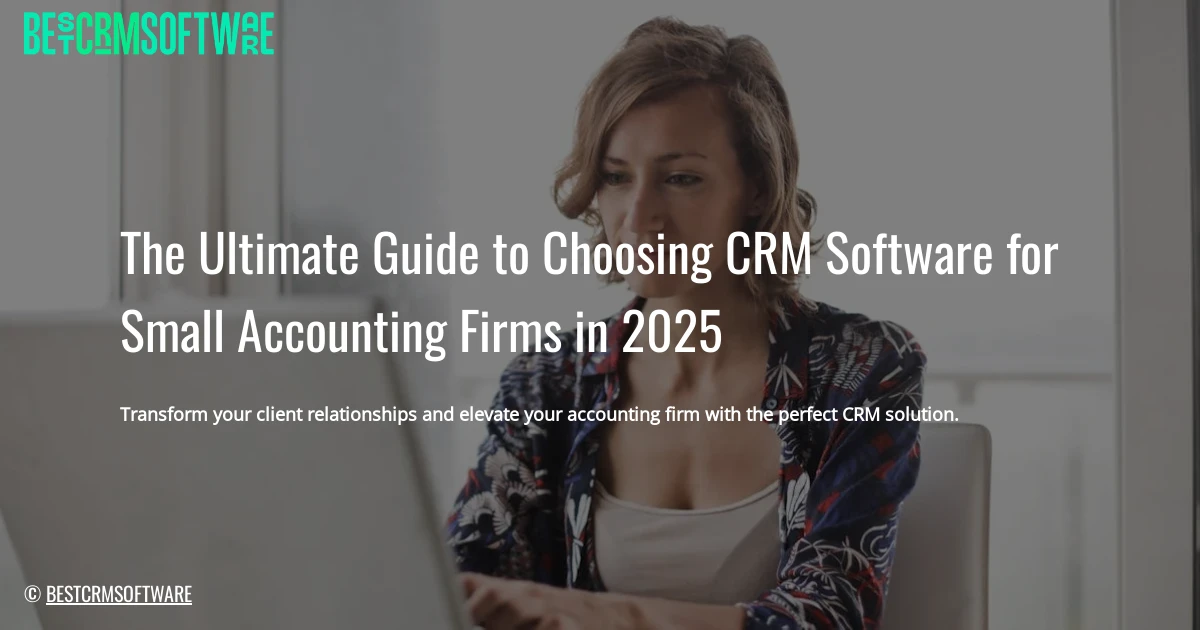Transform your client relationships and elevate your accounting firm with the perfect CRM solution.
Introduction: Navigating the CRM Landscape in 2025
As an accounting firm in 2025, you’re facing a dynamic landscape with increasing competition and evolving client
expectations. A powerful CRM solution is no longer a luxury; it’s a necessity for thriving. But choosing the right CRM
can be daunting. This guide aims to equip you with the knowledge to confidently select the CRM software that perfectly
fits your small firm’s unique needs.
Here’s a three-pronged approach to get you started:
1. Understand Your Specific Needs and Pain Points:
Before embarking on the CRM search, take a step back and delve into your firm’s current processes and challenges. What
are the specific needs and pain points impacting your efficiency, client satisfaction, and growth?
- Client management: Do you struggle to maintain organized client data, track interactions, and
manage tasks efficiently? - Workflow automation: Are routine tasks, like sending reminders or generating reports, eating
away at valuable time? - Reporting and analytics: Do you lack real-time insights into client behavior, performance
metrics, and potential growth areas? - Collaboration and communication: Are internal communications siloed, leading to missed
deadlines and client dissatisfaction?
Answering these questions provides a clear understanding of what your ideal CRM should address.
2. Identify Key Features for Success:
Once you have a grasp of your pain points, start outlining the core features that align with your firm’s goals.
- Client Management: Seek a CRM that seamlessly manages client data, tracks interactions, and
allows for personalized communication. Look for features like contact management, lead scoring, and
segmentation. - Workflow Automation: Look for functionalities like automated email triggers, task scheduling,
and automated reporting to free up your team’s time. Consider how these features streamline daily operations and
increase productivity. - Reporting Capabilities: The CRM should offer robust reporting features that deliver actionable
insights. This could include tracking key performance indicators (KPIs), analyzing client engagement, and
forecasting revenue. - Integration: Look for CRM solutions that smoothly integrate with your existing accounting
software, including programs like Xero, QuickBooks, or Sage.
3. Consider Practical Considerations:
Finally, factor in practical considerations that will shape your decision:
- Budget: Define your budget range and identify CRM solutions within that scope.
- Scalability: Ensure the CRM solution can adapt to your future growth needs, accommodating a
growing client base and team size. - User Friendliness: Choose a user interface that is intuitive and easily adopted by your team,
even those with limited tech skills.
By meticulously considering these points, you’ll be well-equipped to select a CRM that elevates your firm’s efficiency,
empowers client relationships, and paves the way for long-term success in 2025 and beyond.
Step 1: Assess Your Firm’s Unique Needs
Before diving into the exciting world of CRM software, it’s crucial to understand your firm’s specific requirements.
This groundwork will ensure you choose a solution that truly meets your needs and sets you up for success in the long
run. Consider the following factors:
1. Define the size of your firm and projected growth:
- Are you a solo practitioner, a small team, or a rapidly growing firm?
- What is your anticipated growth trajectory over the next few years?
- The answer will determine the features, capacity, and scalability required from your CRM. Smaller firms may opt
for simpler solutions, while larger, growing firms need robust tools with flexible features.
2. Outline the specific services your firm offers:
- Do you primarily focus on tax preparation, bookkeeping, advisory services, or a combination of these?
- Do you provide specialized services within these categories, such as estate planning or financial planning?
- Understanding your firm’s service offerings will guide you towards a CRM with tailored functionalities to
support your business processes. For example, a firm specializing in tax preparation will require robust lead
capture and appointment scheduling features, while a firm focused on financial advisory may need features for
managing client portfolios and financial planning.
3. Determine the number of employees who will need access to the CRM:
- Consider all stakeholders within your firm who require access to client information, including partners,
associates, administrative staff, and potentially external collaborators. - The number of users dictates the required license tiers and access levels, ensuring that everyone can access the
information they need while maintaining appropriate security and privacy measures.
4. Assess your current technology infrastructure and integration requirements:
- Do you use other software like accounting software, practice management tools, or e-signature services?
- Do you need a CRM that integrates seamlessly with these existing tools to streamline workflow and avoid
duplicate data entry? - Assess your existing technology landscape and its compatibility with CRM options to minimize the risk of
disruptions or added complexities.
By diligently addressing these points, you’ll have a solid understanding of your firm’s unique needs and lay the
foundation for a strategic selection of the ideal CRM software. This process sets the stage for an efficient and
successful transition to a more organized, efficient, and client-centric approach.

© Christina Morillo
Step 2: Identify Essential CRM Features for
Accounting Firms
Choosing the right CRM software can significantly streamline your accounting firm’s operations and strengthen client
relationships. But with a plethora of options available, understanding the essential features for your specific needs is
crucial. Here’s a breakdown of key functionalities accounting firms should look for in a CRM solution:
1. Client Relationship Management (CRM): Centralize client data, track interactions, and manage communication
efficiently.
- Centralized Database: A CRM should act as a single source of truth for all client information,
including contact details, past interactions, notes, invoices, and documents. This consolidated view helps you
gain a comprehensive understanding of each client and tailor your interactions effectively. - Communication Management: The ability to track all communication channels – emails, calls,
texts, and meetings – is critical. A CRM should allow you to record interactions, schedule follow-ups, and
generate automated reminders to ensure consistent client engagement.
2. Workflow Automation: Automate repetitive tasks, improve accuracy, and enhance overall efficiency.
- Task Automation: Automating routine tasks like sending welcome emails, scheduling follow-ups,
or sending reminders for payment deadlines can significantly free up your team’s time and reduce the risk of
manual errors. - Workflow Management: Define and manage workflows for different scenarios, such as onboarding
new clients, processing tax returns, or handling client inquiries. Automated workflows can help standardize
procedures and ensure consistent service delivery.
3. Reporting and Analytics: Gain valuable insights into client data, track key performance indicators (KPIs),
and make informed business decisions.
- Data Visualization: A CRM should provide dashboards and reports that offer visual
representations of key metrics, such as client acquisition rates, revenue growth, and customer satisfaction.
This empowers you to monitor performance, identify trends, and make data-driven decisions. - Customizable Reports: You should be able to create custom reports that specifically address
your firm’s needs. Analyze client segmentation, identify areas for improvement, and optimize your marketing and
sales strategies based on insightful data.
4. Integration Capabilities: Ensure seamless integration with existing accounting software (e.g., QuickBooks,
Xero), email marketing platforms, and other business tools.
- Data Synchronization: Avoid data silos and streamline operations by ensuring seamless
integration with your accounting software. Syncing data between your CRM and accounting platforms ensures a
unified view of financial transactions, invoices, and client information. - Third-Party Integrations: The CRM should offer APIs or integration tools for seamless
connection with other tools your firm utilizes, such as email marketing platforms, project management systems,
and document storage solutions. This helps create a cohesive workflow across your business applications.
5. Security and Compliance: Prioritize CRM solutions that meet industry-standard security protocols and ensure
the protection of sensitive client data (e.g., GDPR, CCPA).
- Data Encryption: Encryption is essential to protect client data both at rest and in transit.
- Access Controls: Establish granular access control permissions to restrict sensitive
information based on user roles and responsibilities. - Regular Security Audits: Ensure the CRM provider conducts regular security audits and maintains
compliance with relevant data privacy regulations such as GDPR, CCPA, and other regional requirements.
By carefully considering these essential CRM features, you can select a solution that empowers your accounting firm to
efficiently manage client relationships, automate key processes, and gain insightful data for informed decision-making.
Step 3: Cloud-Based vs. On-Premise CRM:
Weighing the Pros and Cons
Choosing between cloud-based and on-premise CRM software is a crucial step in selecting the right solution for your
small accounting firm. Both options offer distinct advantages and disadvantages, requiring a careful assessment of your
specific needs and priorities.
Cloud-Based CRM:
Benefits:
- Accessibility: Access your CRM from anywhere with an internet connection, enabling remote work
and team collaboration. - Scalability: Easily scale your CRM system up or down based on your firm’s growth, adding users
and features as needed without significant investment. - Cost-Effectiveness: Typically lower upfront costs with predictable monthly subscriptions,
reducing the financial burden. - Automatic Updates: Benefit from regular updates and security patches, ensuring you always have
access to the latest features and a secure environment. - Disaster Recovery: Data is stored on secure servers with regular backups, ensuring data
integrity and minimizing the risk of data loss.
On-Premise CRM:
Consider:
- Control over Data: You maintain complete control over data storage and security within your own
infrastructure. - Customization Options: Potentially more customization options for your CRM, tailoring it
precisely to your firm’s specific requirements. - Initial Investment Costs: Requires a significant initial investment for software licensing and
hardware infrastructure. - Maintenance Responsibilities: Responsibility for maintaining, updating, and securing the CRM
system falls solely on your firm. - Potential Scalability Limitations: Adding new users or features might require more complex and
expensive upgrades.
Ultimately, the best option for your accounting firm depends on your unique circumstances. Consider
factors like:
- Budget: Cloud-based CRMs often have lower upfront costs but may require ongoing subscriptions.
On-premise options may require a significant initial investment. - Technical Expertise: Do you have the technical resources to manage and maintain an on-premise
CRM? - Data Security and Privacy: Evaluate the data security practices of both cloud-based providers
and your own on-premise capabilities. - Scalability: How likely is your firm to grow in the near future? Consider the flexibility and
ease of scaling each option.
By weighing these factors, you can confidently decide whether a cloud-based or on-premise CRM is the best fit for your
small accounting firm and its unique needs in 2025.

© Christina Morillo
Step 4: Research and Shortlist Potential CRM Solutions
Once you have a clear understanding of your specific needs and requirements, it’s time to dive into the research phase.
This involves identifying, evaluating, and shortlisting CRM solutions that could be a good fit for your accounting firm.
Here’s how:
- Research leading CRM providers specializing in solutions tailored for accounting firms. Instead
of generic CRM platforms, seek out those specifically designed to meet the unique challenges and requirements of
the accounting industry. Some reputable options include:- Zoho CRM: Offers robust features, customizable workflows, and integrates seamlessly
with various accounting software. - HubSpot CRM: Provides comprehensive marketing automation and sales tools, suitable for
attracting and engaging potential clients. - Salesforce Financial Services Cloud: Designed for financial institutions, it includes
functionalities specifically catered towards wealth management and investment services.
- Zoho CRM: Offers robust features, customizable workflows, and integrates seamlessly
- Compare pricing plans and ensure they align with your budget and projected growth. Each CRM
vendor will have different pricing models, so carefully review their plans and determine the one that best fits
your firm’s financial resources. Consider both the current costs and future scalability as your firm expands. - Explore free trial options to test different CRM solutions and evaluate their
user-friendliness. Most CRM vendors offer free trial periods, providing you with the opportunity to
try before you buy. Utilize this time to test the system, explore various features, and see how user-friendly
the platform is. Pay close attention to the features you identified as essential in your needs analysis. - Read online reviews from other accounting professionals to gain insights into user experiences and
potential drawbacks. Websites like G2 Crowd, Capterra, and Software Advice offer valuable user
feedback on various CRM solutions. Reading these reviews will help you gauge the pros and cons of each platform
and learn about real-world experiences. - Contact sales representatives to discuss specific needs, request demos, and ask relevant
questions. Engage directly with the vendor’s sales team to get a more personalized understanding of
their offerings. Clearly articulate your requirements and use this interaction to:- Request demonstrations to see the CRM in action.
- Seek clarification on specific functionalities and integration possibilities.
- Negotiate customized pricing plans if needed.
By carefully following these steps, you will be able to identify a shortlist of potential CRM solutions that meet your
needs and budget, preparing you for the next step: conducting in-depth trials and comparing shortlisted candidates.
Step 5: Evaluate User-Friendliness and Customer Support
Choosing the right CRM software isn’t just about features, it’s also about how those features translate into a positive
user experience. This step involves assessing the software’s usability and the reliability of the vendor’s support:
1. Test with Real Client Data and Simulate Daily Workflows: Don’t just rely on demos or tutorials. Load
your shortlisted CRMs with real client data and put them through the paces of your typical daily operations.
- Track client interactions: Create fake contacts, notes, and emails to see how the CRM handles
basic communication and follow-up. - Simulate lead capture and management: Go through the steps of acquiring new clients, recording
contact information, and tracking their journey. - Map out financial workflows: Enter dummy transactions, manage billing and invoicing, and check
how the CRM integrates with your existing accounting systems.
This real-world testing will give you a clear picture of how the CRM functions in your actual working environment and
identifies any potential bottlenecks or user friction.
2. Involve Key Stakeholders in the Evaluation Process: Get input from the entire team.
- Accounting team: They’ll appreciate seamless integration with your existing accounting systems
and efficient ways to track client financials. - Sales and marketing team: Their priorities might be lead generation, pipeline management, and
customer engagement features. - Administrative staff: They need a user-friendly system for managing contacts, schedules, and
communications.
By including different perspectives, you can ensure the chosen CRM caters to everyone’s needs and supports smooth
collaboration across your firm.
3. Focus on User Interface (UI), Ease of Navigation, and Overall Intuitiveness: The best CRM is one
that is user-friendly, easy to learn, and enjoyable to use.
- Visual design: Look for clean, clear layouts, intuitive icons, and logical menus that simplify
information access. - Navigation: Assess the ease of navigating between screens, finding specific clients, and
accessing data quickly. - Training materials: Look for comprehensive documentation, tutorials, and support videos that
make the learning curve as smooth as possible.
A user-friendly CRM will be adopted faster by your team, minimizing the initial onboarding period and leading to better
engagement.
4. Assess the Quality and Responsiveness of Customer Support: Your CRM vendor will be your partner
during implementation, so it’s essential to have reliable support in place.
- Response times: Test their support channels (phone, email, live chat) to see how quickly you
get replies and problem resolutions. - Knowledge base and documentation: Assess the comprehensiveness of their online resources and
FAQs. - Proactive communication: Check if the vendor provides regular updates, announces new features,
and addresses potential issues proactively.
A strong support team can be a crucial resource when implementing and adapting the CRM. Choose a vendor who’s invested
in your success beyond the initial purchase.
By carefully evaluating these factors, you can choose a CRM software that seamlessly integrates into your firm’s
operations, empowers your team, and ultimately helps you grow your business.

© Pixabay
Step 6: Seamless CRM Implementation and Adoption
Successfully implementing a CRM system isn’t just about choosing the right software; it’s about ensuring smooth adoption
and integration into your firm’s workflow. This requires careful planning, strategic execution, and consistent
communication. Here’s how to achieve seamless CRM implementation and adoption in your small accounting firm:
1. Data Migration: A Well-Crafted Blueprint for Client Data
Migrating your existing client data to the new CRM is crucial. This step involves meticulously planning and executing
the process to minimize disruption and data loss. Consider the following:
- Develop a comprehensive data migration plan: Clearly define the scope of the data migration,
identify the data sources, and create a detailed schedule for each phase of the process. - Data cleansing and validation: Ensure accuracy by cleaning and validating existing client data
before migrating it. - Choosing the right migration method: Evaluate options like manual data entry, data mapping, or
automated tools. Select the method that best aligns with your specific data and resources. - Test and verify: Thoroughly test the data migration process in a staging environment to ensure
accuracy and completeness. - Ensure security: Employ robust security measures throughout the data migration process to
safeguard client information.
2. Training and Onboarding: Empowering Your Team
Thorough training is essential to equip your team with the knowledge and skills necessary to utilize the CRM system
effectively.
- Structured training programs: Offer interactive and tailored training programs for each user
group, covering all key CRM features and functionalities. - Ongoing support and resources: Establish a knowledge base, FAQ section, and readily available
support channels to provide ongoing assistance. - Practical exercises and scenarios: Include hands-on exercises and simulations to help employees
understand the application of the CRM within their roles. - Regular review sessions: Schedule regular check-ins to ensure staff comprehension, address any
difficulties, and continuously enhance training materials.
3. Data Security: Building Trust and Protection
Protecting sensitive client information is paramount. Ensure data security is prioritized throughout the implementation
and ongoing use of the CRM system.
- Implement access controls: Grant different levels of access based on user roles and
responsibilities to prevent unauthorized access. - Encryption of sensitive data: Encrypt all client information at rest and in transit to
safeguard against unauthorized access or data breaches. - Regular data backups: Establish a robust backup plan to protect data against any unforeseen
data loss or system failure. - Compliance with relevant regulations: Ensure adherence to data privacy regulations like GDPR
and CCPA to protect client data.
4. Change Management: Embracing the Transformation
Effectively communicate the CRM implementation and its benefits to your staff. Addressing concerns and creating buy-in
is vital for smooth adoption.
- Communicate transparently: Provide clear and concise information about the CRM implementation,
its goals, and anticipated benefits for the firm and employees. - Address staff concerns: Engage in open dialogue to address concerns, acknowledge potential
challenges, and emphasize the importance of collaboration. - Highlight the value proposition: Clearly communicate how the CRM will simplify workflows,
improve efficiency, and enhance client service, ultimately contributing to the overall success of the firm. - Positive reinforcement and feedback: Recognize and acknowledge early adopters and showcase the
positive impact of the CRM on firm performance.
By prioritizing these crucial steps, your small accounting firm can effectively implement and adopt a CRM system,
driving enhanced productivity, stronger client relationships, and a streamlined, data-driven operation.
Step 7: Leveraging CRM for Enhanced
Efficiency and Client Satisfaction
In the competitive landscape of 2025, accounting firms must prioritize efficiency and client satisfaction to thrive. A
well-chosen CRM can be your secret weapon in achieving both. Here’s how:
1. Streamlining Client Intake:
- Digitize and automate the client onboarding process. Say goodbye to paper forms and manual data
entry. A CRM with integrated forms and e-signatures allows for seamless client onboarding, minimizing errors and
saving precious time. - Reduce administrative overhead. By automating data capture and routing, you can significantly
reduce administrative tasks, allowing your team to focus on higher-value activities.
2. Improving Communication and Engagement:
- Personalize client communications. Use CRM data to segment clients based on their needs and
tailor communications accordingly. This creates a more personalized experience, fostering stronger
relationships. - Schedule automated reminders. Don’t let important deadlines slip through the cracks. Automated
reminders for tax deadlines, invoice payments, or follow-ups ensure your clients stay informed and engaged.
3. Automating Task Management:
- Optimize task assignments. CRM systems can streamline task management by assigning tasks based
on skillset and workload, ensuring efficient allocation of resources. - Set deadlines and track progress effectively. Gain complete visibility into project timelines
and ensure deadlines are met through integrated task management and progress tracking features within the CRM.
4. Managing Leads and Opportunities:
- Track potential clients and nurture leads. CRM provides tools to capture and qualify leads,
nurturing them through targeted communication and engagement. - Convert leads into loyal customers. By understanding their needs and providing valuable
insights, you can convert leads into long-term clients, fostering a sustainable and profitable client base.
By leveraging CRM for these key functions, you can unlock significant efficiency gains and build stronger, more
satisfying client relationships. Your accounting firm will be well-positioned to not only manage but also exceed client
expectations in the ever-evolving business environment of 2025.

© Pixabay
Step 8: Measuring Success: Analyzing Data and
Refining Strategies
Choosing the right CRM isn’t just about implementation, it’s about maximizing its potential to drive your firm’s growth.
That’s where data analysis and strategy refinement come in. Here’s how you can leverage your CRM to truly unlock its
power:
1. Track Key Performance Indicators (KPIs): Your CRM can be a goldmine of insights. Focus on tracking
KPIs crucial for your firm’s success:
- Client Acquisition Cost: How much are you spending to acquire new clients? Understanding this
cost allows you to optimize your marketing efforts. - Customer Lifetime Value (CLTV): This metric tells you the total revenue you can expect from a
client over their relationship with your firm. Knowing your CLTV helps you identify your most valuable clients
and invest accordingly. - Client Satisfaction: Implement customer satisfaction surveys, feedback forms, or even automated
reviews within your CRM. Understanding client sentiment is key to retaining them and attracting new business.
2. Generate Insightful Reports: Don’t just gather data; interpret it. Your CRM should offer reporting
capabilities that allow you to:
- Analyze trends: Identify recurring patterns in client behavior, marketing success, and staff
performance to proactively address needs and optimize strategies. - Identify areas for improvement: Are certain aspects of your client interactions lagging? The
CRM’s reports can highlight areas needing attention to ensure seamless experiences. - Measure the return on investment (ROI): Your CRM isn’t a cost, it’s an investment. Utilize
reports to track the tangible impact it’s having on your bottom line, from client acquisition to retention and
revenue generation.
3. Leverage Data for Data-Driven Decisions: The information gleaned from your CRM isn’t just for
analysis. Use it to empower strategic decision-making:
- Enhance efficiency: Identify tasks, workflows, or communication channels hindering productivity
and optimize them based on data insights. - Boost productivity: Use CRM insights to forecast workloads, allocate resources effectively, and
identify opportunities for automation. - Increase client satisfaction: Identify customer segments with distinct needs and tailor your
services accordingly. Leverage feedback to enhance client communication, personalization, and service quality.
By following these steps and actively analyzing the wealth of data at your fingertips, your accounting firm can achieve
remarkable results. The CRM doesn’t just organize your business; it transforms it into a data-driven, efficient, and
client-centric entity, poised for growth and success in 2025 and beyond.
Step 9: Looking Ahead: CRM Trends Shaping the
Future of Accounting
As we head towards 2025, the accounting landscape is rapidly evolving, and CRM systems need to adapt. Here’s a glimpse
into the future, highlighting trends that small accounting firms should be mindful of:
1. Artificial Intelligence (AI) and Machine Learning (ML): The rise of AI and ML will dramatically
reshape the role of CRM in accounting. Look for solutions that leverage these technologies for:
- Intelligent Automation: Streamline repetitive tasks like data entry, appointment scheduling,
and client communication through AI-powered bots. - Predictive Analytics: Gain deeper insights into client behavior, predict future needs, and
anticipate potential issues by leveraging predictive models. - Personalized Insights: Personalize client interactions, offer tailored solutions, and optimize
your service delivery with AI-driven recommendations and insights.
2. Data Security and Privacy: Cybersecurity is paramount in accounting. Choose CRM software that
prioritizes:
- Robust Security Measures: Implement multi-factor authentication, data encryption, access
control, and other robust security measures to safeguard sensitive financial information. - Data Encryption: Ensure that client data is encrypted both at rest and in transit to prevent
unauthorized access. - Compliance with Regulations: Select CRM solutions that comply with industry-specific
regulations such as GDPR, CCPA, and HIPAA to protect sensitive information and avoid legal ramifications.
3. Integrations with Emerging Technologies: Be prepared to embrace cutting-edge technologies that
seamlessly integrate with your CRM to unlock new opportunities:
- Blockchain: Utilize blockchain technology for secure and tamper-proof data management, ensuring
trust and transparency in financial transactions. - Robotic Process Automation (RPA): Automate complex processes like account reconciliation,
invoice processing, and data migration with RPA to boost efficiency and free up time for higher-value
activities.
By embracing these trends, small accounting firms can position themselves at the forefront of innovation and leverage
CRM technology to enhance their client experiences, streamline operations, and thrive in the ever-evolving business
landscape of 2025 and beyond.

© Alexander Suhorucov
Conclusion: CRM as a Strategic Investment for
Long-Term Success
As you embark on the journey of selecting a CRM for your small accounting firm, remember that a well-chosen system is
more than just a tool—it’s a strategic investment. By focusing on these key aspects, your CRM can drive significant
growth and elevate your firm to new heights:
- Enhanced Client Relationships: A CRM’s ability to streamline communication, manage client
interactions, and personalize service builds trust and loyalty, transforming clients into valuable advocates. - Optimized Firm Operations: From automated tasks to centralized data access, a CRM fosters
efficiency, frees up time for high-value activities, and improves collaboration across the team. - Future-Proof Adaptability: Embrace CRM platforms that are adaptable to emerging technologies
and evolving client expectations. Staying ahead of the curve ensures your firm remains competitive and
responsive to industry advancements.
Think beyond short-term gains and envision your CRM as a cornerstone for your firm’s long-term success. It’s an
investment that will enhance client satisfaction, boost operational efficiency, and position your accounting
practice for sustainable growth in the competitive landscape of 2025 and beyond.
Emerging Trends: The Future of CRM for Accountants
The accounting landscape is evolving rapidly, and staying ahead of the curve is crucial for small firms. The future of
CRM for accountants is focused on seamless integration, intelligent automation, and mobile-first accessibility,
unlocking a new level of efficiency and client engagement. Here’s a look at three emerging trends shaping the CRM
experience for accounting professionals:
1. Mobile Accessibility:
In a world where remote work and flexibility reign supreme, accountants need access to client information and management
tools anytime, anywhere. This necessitates CRM solutions optimized for mobile devices.
The benefit:
- Seamless Client Management: Access and update client information, manage tasks, and track
communication from your phone, freeing you from the limitations of your desk. - Real-Time Responsiveness: Address client queries promptly regardless of location, enhancing
client satisfaction and building stronger relationships.
2. Voice Search Optimization:
Voice search is revolutionizing how people interact with technology. Your CRM needs to be voice-search ready to embrace
this shift and offer a faster, more intuitive user experience.
The benefit:
- Effortless Information Retrieval: Ask your CRM platform voice commands to access client
information, schedule appointments, or find important documents, saving valuable time and streamlining workflow. - Simplified Task Management: Dictate task details, send reminders, and delegate
responsibilities, maximizing productivity through voice commands.
3. Enhanced Collaboration Features:
Effective collaboration is essential for the smooth operation of a small accounting firm. The future of CRM promises to
integrate seamlessly with team communication tools and knowledge sharing platforms.
The benefit:
- Improved Team Communication: Access real-time project updates, collaborate on client files, and
seamlessly communicate with team members within the CRM platform, reducing ambiguity and misunderstandings. - Knowledge Sharing & Centralized Data: Leverage the CRM as a repository for valuable firm
knowledge and shared information, allowing team members to access crucial insights instantly.
By embracing these emerging trends, small accounting firms can position themselves for success in a dynamic industry.
CRM platforms offering mobile accessibility, voice search optimization, and enhanced collaboration features will become
the competitive advantage of the future.

© Alexander Suhorucov
Top CRM Solutions for Small Accounting Firms
Choosing the right CRM software can be a game-changer for small accounting firms. The right tool can streamline your
client relationships, improve communication, and ultimately boost profitability. But with so many options on the market,
knowing where to start can be overwhelming.
This section delves into nine leading CRM solutions that are particularly well-suited for small accounting firms in
2025:
1. Zoho CRM
Zoho CRM stands out for its comprehensive suite of features at a competitive price point. Small accounting firms can
leverage features like:
- Robust contact management: Organize client information, track interactions, and segment clients
based on their financial needs. - Automated workflows: Automate tasks like sending invoices, scheduling follow-ups, and creating
reports, freeing up time for more strategic work. - Integration with accounting software: Seamlessly connect with platforms like Xero and
QuickBooks to access real-time financial data and optimize client interactions. - Marketing automation capabilities: Nurture leads and build brand awareness through targeted
email campaigns and other marketing tools.
2. HubSpot CRM
HubSpot’s free CRM provides a strong foundation for small accounting firms starting their CRM journey. Key features
include:
- Intuitive and easy-to-use interface: Ideal for teams with limited CRM experience.
- Excellent free plan: Offers core CRM functionality without any costs, allowing firms to test
and get comfortable before upgrading. - Built-in marketing automation tools: Send personalized emails, track website activity, and
engage potential clients with engaging content. - Scalability: HubSpot offers paid plans to accommodate growing businesses with expanded
functionalities like reporting, advanced automation, and team collaboration.
3. Salesforce Financial Services Cloud
For accounting firms that prioritize robust financial services-specific capabilities, Salesforce Financial Services
Cloud emerges as a strong contender:
- Financial data integration: Seamlessly integrates with accounting systems and provides access
to crucial financial information like account balances, transaction history, and investment portfolios. - Comprehensive client portal: Empower clients with self-service tools to access their account
information, download documents, and manage tasks. - Streamlined compliance management: Simplify regulatory compliance through built-in features
like KYC/AML compliance and data security tools. - Customizable dashboards and reports: Gain insights into client behaviour, track key metrics,
and identify areas for improvement.
4. Pipedrive
Pipedrive excels in helping accounting firms visualize their sales pipelines and stay on top of opportunities.
- Powerful sales pipeline management: Effectively track deal progress, identify potential
roadblocks, and prioritize tasks. - Automated sales workflows: Automate repetitive tasks such as follow-up emails, appointment
scheduling, and proposal creation. - Intuitive mobile app: Manage your CRM on the go, even when away from your computer.
- Customizable dashboards: Track key performance indicators, measure sales progress, and optimize
your firm’s performance.
5. Insightly
Insightly combines CRM functionality with robust project management tools, making it a suitable choice for accounting
firms offering consulting or advisory services.
- Unified view of clients: Gain a comprehensive overview of clients, projects, and financials all
within one platform. - Effective project management capabilities: Organize projects, track tasks, manage deadlines,
and ensure client projects stay on track. - Flexible reporting options: Track performance, generate customized reports, and share insights
with your team. - Extensive integrations: Integrate with popular accounting software, project management tools,
and other business applications.
6. Freshsales
Freshsales is another powerful CRM solution offering an intuitive interface and feature-rich functionality, making it a
popular choice for small and growing accounting firms.
- Lead scoring and prioritization: Efficiently score potential clients based on various criteria
to focus efforts on those most likely to convert. - Comprehensive lead nurturing: Create automated campaigns to engage potential clients, answer
their questions, and guide them through the sales funnel. - Powerful communication tools: Utilize features like phone, email, and chat to interact with
clients from within the CRM platform. - Cost-effective pricing: Offer multiple plans to cater to different business needs and budgets.
7. Agile CRM
Agile CRM provides a comprehensive all-in-one solution that combines CRM, marketing automation, and social media
management tools.
- Marketing automation at your fingertips: Send targeted email campaigns, nurture leads, and
automate social media engagement. - Advanced reporting and analytics: Track key performance indicators, measure ROI on marketing
efforts, and gain deeper insights into client behavior. - Real-time dashboards: Gain a clear understanding of your sales pipeline, marketing performance,
and client engagement. - Multi-channel communication: Effectively communicate with clients through email, phone, SMS,
chat, and social media platforms.
8. Keap
Keap, previously known as Infusionsoft, specializes in helping businesses grow and automate their operations.
- Lead capture and automation: Efficiently capture leads, segment them based on interests and
preferences, and nurture them with targeted communications. - Integrated marketing automation: Create engaging landing pages, email sequences, and follow-up
systems to guide leads through the sales funnel. - Advanced reporting and analytics: Gain valuable insights into customer behaviour, marketing
effectiveness, and overall business performance. - E-commerce integrations: Seamlessly connect with online stores to manage sales, track orders,
and facilitate online customer support.
9. Less Annoying CRM
Less Annoying CRM stands out for its simplicity and ease of use. Its focus on user-friendliness makes it a good choice
for accounting firms with small teams or those who prioritize a quick and painless implementation process.
- Minimalist interface: Simple and intuitive, even for users without extensive CRM experience.
- Limited but sufficient functionality: Offers core CRM capabilities including contact
management, task management, and basic reporting. - Competitive pricing: Affordably priced and scalable for growing businesses.
- Great customer support: Highly responsive and helpful customer support team to assist with
onboarding and troubleshooting.
The specific needs and goals of each accounting firm will determine the most suitable CRM solution. By carefully
considering the functionalities, integrations, pricing, and customer support offered by each of these top contenders,
you can make an informed decision that will help you streamline operations, enhance client relationships, and propel
your firm towards continued success in the competitive landscape of 2025.
Budgeting for Your CRM Investment
Choosing the right CRM software is crucial for your firm’s success, but so is understanding the associated costs. A
thoughtful budget will ensure you select a solution that fits your needs and financial capacity. Here’s a breakdown of
key budget considerations:
1. Cost of the CRM Software:
- Subscription Fees: Subscription-based CRMs are common, and costs vary widely depending on
features, user count, and integration capabilities. - Implementation Costs: Consider the costs involved in getting the CRM up and running, which
might include setup fees, customization, and data migration.
2. Potential Return on Investment (ROI):
- Increased Efficiency: CRM software can streamline workflows, automate tasks, and free up staff
time for more valuable client engagements. Quantify these efficiency gains to project the financial benefits. - Improved Client Satisfaction: Enhanced client communication, personalized experiences, and
better issue resolution can lead to higher retention rates, increased referrals, and overall client
satisfaction. This translates into tangible revenue gains.
3. Training and Onboarding Expenses:
- Staff Training: Invest in proper training to ensure staff fully understand the CRM and leverage
its features effectively. Costs can vary based on the complexity of the software and the number of users. - Onboarding Support: Factor in costs associated with onboarding new employees and integrating
them into your CRM processes.
4. Data Migration Costs (If Applicable):
- Moving Data: If you are transitioning from another system, migrating your client and financial
data to the new CRM can be a significant cost. Factor in data cleaning, conversion, and potential expert
assistance.
5. Ongoing Maintenance and Support Fees:
- Ongoing Support: Many CRM providers offer maintenance and support packages that cover technical
issues, software updates, and regular system maintenance. These fees can vary depending on the level of support
provided.
Tips for Effective Budgeting:
- Research and Compare: Don’t settle for the first CRM you find. Compare pricing, features, and
support offerings from several providers. - Evaluate Needs and Priorities: Determine the most critical CRM functions for your firm and
prioritize your budget allocation accordingly. - Consider ROI: Calculate the potential financial benefits of the CRM system to justify its cost
and ensure it’s a strategic investment. - Factor in Long-Term Costs: Remember that ongoing costs like subscription fees, maintenance, and
support can significantly impact your budget.
By meticulously planning and budgeting for your CRM investment, you’ll set your firm up for long-term success and
profitability. A CRM system, when chosen thoughtfully, can significantly elevate your operations and enhance client
experiences in the rapidly evolving accounting landscape of 2025.

© Andrea Piacquadio
Choosing the Right CRM Vendor: Key Considerations
Selecting the ideal CRM for your small accounting firm is a crucial decision. You’re not just buying software; you’re
investing in a tool that will directly impact client relationships, team collaboration, and overall business efficiency.
As you navigate the myriad CRM options available, prioritizing these vendor-centric considerations will help ensure you
choose a partner that delivers value and lasting success.
1. Evaluate the vendor’s track record, reputation, and financial stability.
- Look beyond flashy marketing and delve into the vendor’s history. How long have they been in
business? What’s their experience serving the accounting industry specifically? - Read reviews and industry reports. What do other customers say about their experience? Are
there any recurring issues or complaints? - Consider the vendor’s financial strength. This indicates their long-term commitment to
supporting their product and fostering a healthy ecosystem.
2. Seek references or case studies from other accounting firms.
- Don’t rely solely on the vendor’s own testimonials. Seek out real-world examples of how similar
firms have benefited from the CRM solution. - Talk to other accounting professionals. Get their firsthand insights into the vendor’s
strengths, weaknesses, and any specific challenges they encountered.
3. Assess the vendor’s product roadmap and commitment to innovation.
- Understand the vendor’s future vision for the CRM. Are they actively developing new features
and integrations that align with the evolving needs of the accounting industry? - Look for signs of ongoing improvement and enhancement. This demonstrates the vendor’s
commitment to providing a cutting-edge solution.
4. Inquire about customer support availability, response times, and support channels (e.g., phone, email,
chat).
- Strong customer support is crucial for any software investment. The vendor should offer a
variety of support channels, including quick response times, dedicated technical experts, and comprehensive
documentation. - Don’t hesitate to ask about their customer service policies. How do they handle onboarding and
ongoing support? Are there any additional costs for specific levels of support?
By meticulously addressing these vendor-related considerations, you’ll equip yourself to select a CRM solution that
seamlessly aligns with your firm’s needs and contributes to long-term growth.
Implementing Your CRM Successfully
Choosing the right CRM is just the first step. A successful CRM implementation requires careful planning and execution.
Here’s a guide to ensuring a smooth transition and reaping the full benefits of your chosen software:
1. Define Clear Objectives:
- Start with the “why.” Why are you implementing a CRM? Are you looking to streamline client
communication, improve lead management, or gain insights into your firm’s performance? - Set specific goals. Don’t just say “improve communication” – instead, outline specific targets
like “increase client satisfaction by 15%” or “reduce customer churn by 10%.” - Define desired outcomes. What does success look like? Increased sales revenue? Enhanced client
retention? Streamlined operations? - Be realistic. Your goals should be ambitious but achievable within a reasonable timeframe.
2. Establish Realistic Timelines & Milestones:
- Break down the implementation into manageable phases. This might include data migration, user
training, customization, and integration with existing systems. - Assign clear deadlines to each phase. Avoid delaying implementation, as it can impact user
buy-in and hinder the benefits. - Consider factors like staff availability, resource allocation, and vendor support when setting
deadlines.
3. Designate a Dedicated Project Manager:
- A single point of contact is essential for smooth implementation.
- The project manager oversees the entire process, coordinating tasks, addressing roadblocks, and ensuring
deadlines are met. - They act as a liaison between the firm, CRM vendor, and stakeholders, ensuring open communication
throughout the process.
4. Communicate Regularly with Stakeholders:
- Keep staff informed throughout the implementation. Explain the benefits of the CRM, address
their concerns, and offer training to ensure they are comfortable using the system. - Provide regular updates to management on progress. Be transparent about challenges faced and
potential solutions. - Maintain open communication with the CRM vendor. This includes seeking clarification on
functionalities, reporting issues, and requesting support.
By meticulously planning, establishing clear objectives, and ensuring consistent communication, your firm can smoothly
integrate its new CRM and reap its rewards for a successful future.

© Andrea Piacquadio
Beyond Implementation: Maximizing Your CRM Investment
While selecting the right CRM software is crucial, its true value lies in how you implement and leverage it. Here are
key strategies to ensure you’re maximizing your CRM investment beyond just implementation:
- Integrate CRM data with other business systems to streamline workflows.
Connecting your CRM with your accounting software, project management tools, and even email marketing platforms
can create a powerful, unified system. Imagine pulling up client data directly within your accounting software,
updating contact information across all systems automatically, or sending targeted marketing campaigns based on
specific accounting triggers. These seamless integrations eliminate data silos and automate tedious tasks,
freeing up time for more strategic initiatives. - Customize dashboards and reports to monitor key metrics.
Don’t settle for generic reports. Customize your CRM dashboard and reports to focus on metrics relevant to your
accounting firm’s goals. Track lead conversion rates, client acquisition costs, average revenue per client, and
other critical KPIs. Use these insights to make data-driven decisions about your sales and marketing strategies,
improve client retention, and identify areas for operational efficiency. - Provide ongoing training to employees to maximize CRM adoption.
Even the best CRM software is useless if your team isn’t using it properly. Invest in comprehensive training
programs that go beyond the basics. Teach your staff advanced functionalities, like lead scoring, automated
workflows, and campaign management. Foster a culture of CRM usage through regular reminders, ongoing support,
and incentives for utilizing the tool effectively. - Continuously evaluate and optimize your CRM strategies.
CRM isn’t a set-it-and-forget-it solution. Regularly assess your CRM performance by analyzing data and
collecting feedback from your team. Identify areas for improvement, adapt your strategy based on changing market
conditions, and keep up with the latest features and functionalities of your chosen CRM platform. This
continuous optimization will ensure your CRM stays relevant and continues to deliver real value to your
accounting firm.
By embracing these strategies, you’ll be able to harness the full power of your CRM and transform it from a simple tool
into a strategic advantage that fuels growth, efficiency, and lasting client satisfaction.
Security and Privacy in Accounting CRM
Accounting firms handle sensitive client data, making security and privacy paramount when selecting a CRM. Choosing the
right software can significantly impact your firm’s reputation and its ability to maintain client trust. Here’s what you
should prioritize:
- Security Standards: Opt for CRM solutions that meet industry standards like ISO 27001 or SOC 2.
These certifications indicate a strong commitment to security and rigorous adherence to best practices. - Data Privacy Compliance: Ensure the CRM complies with relevant data privacy regulations like
GDPR (General Data Protection Regulation) and CCPA (California Consumer Privacy Act), depending on your location
and clientele. This compliance is essential to protect client information and avoid potential penalties. - Data Backup and Recovery: Regularly back up your CRM data to prevent data loss. This safeguard
is crucial for ensuring the continuity of your business operations and the protection of sensitive client
information. Implement a robust backup strategy, including regular backups and offsite storage, to mitigate the
risks of data breaches, hardware failures, or natural disasters.
Remember, choosing a CRM is not just about finding features, it’s also about establishing a foundation of trust and
security. Investing in a CRM that meets these security and privacy requirements will provide peace of mind and
demonstrate your commitment to client data protection.

© Emmy E
Embracing Automation and AI in Your Accounting CRM
The modern accounting landscape demands more than just accurate bookkeeping. Small accounting firms need to be
efficient, data-driven, and adaptable. This is where automation and artificial intelligence (AI) within your CRM become
powerful allies.
Automation can free up valuable time, allowing you to focus on higher-value tasks. Imagine a world
where routine tasks like data entry, invoice generation, and client communication are handled automatically. This is the
reality offered by automated CRM features:
- Automated workflows: Streamline repetitive processes, ensuring tasks are completed on time and
without errors. - Automated data entry: Reduce manual data entry by connecting your CRM to other business
applications, allowing information to flow seamlessly. - Automated reminders: Never miss a deadline again. Set reminders for client follow-ups, payment
deadlines, and more.
AI and predictive analytics provide insights that enhance decision-making. Imagine knowing which
clients are most likely to churn or what marketing campaigns are most successful, all based on real-time data analysis.
This is the power of AI in CRM:
- Predictive analytics: Identify potential risks and opportunities early, allowing you to
proactively adapt your strategies. - Client segmentation: Group clients based on common traits to tailor communication and services
for improved engagement. - Personalized client experiences: AI can analyze past interactions and provide insights to
personalize communications and enhance client satisfaction.
By embracing automation and AI within your CRM, small accounting firms can:
- Increase efficiency and productivity: Freeing up time for more strategic work.
- Enhance data-driven decision making: Gaining insights to drive growth and profitability.
- Improve client relationships: Delivering personalized experiences and exceptional service.
This combination of automation and AI isn’t a luxury – it’s a necessity for any accounting firm seeking to thrive in the
evolving digital landscape. Choose a CRM that leverages these cutting-edge tools to empower your firm to excel in 2025
and beyond.
Resources
BEST ACCOUNTING CRM | CONVERGEHUB
TOP CRM SOFTWARE AND SYSTEMS 2024/2025 – CLOUD CONSULTINGS
TOP 10 CRM TOOLS FOR SMALL BUSINESSES – LINKEDIN
HOW TO CHOOSE THE RIGHT CRM SOFTWARE FOR YOUR BUSINESS – GRAFFERSID
THE BEST SMALL BUSINESS SOFTWARE IN 2024: OUR EXPERT GUIDE
ODOO CRM VS. ZOHO | INDEPENDENT COMPARISON – YOUTUBE
<!–
–>

